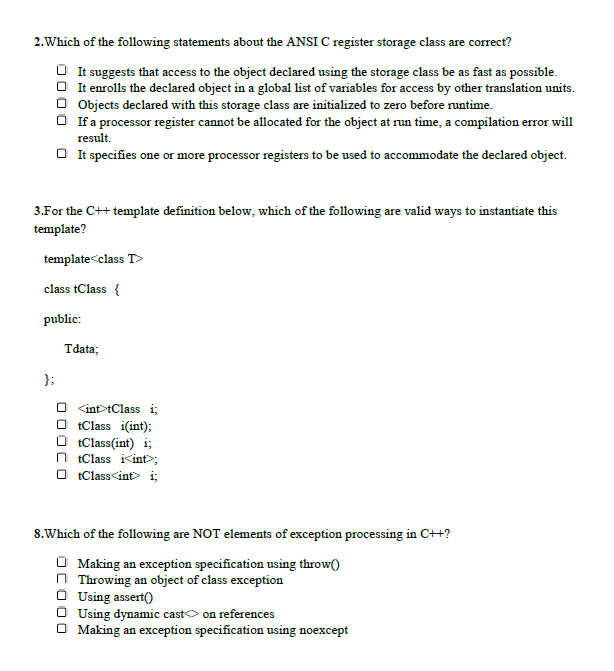
Computer Networking: A Top-Down Approach (7th Edition)
7th Edition
ISBN: 9780133594140
Author: James Kurose, Keith Ross
Publisher: PEARSON
expand_more
expand_more
format_list_bulleted
Question
thumb_up100%
Please choose which options are correct of below questions, no need of explanation of that question but answer all the questions( please answer all the three questions below given)

Transcribed Image Text:2.Which of the following statements about the ANSI C register storage class are correct?
O It suggests that access to the object declared using the storage class be as fast as possible.
O It enrolls the declared object in a global list of variables for access by other translation units.
O Objects declared with this storage class are initialized to zero before runtime.
If a processor register cannot be allocated for the object at run time, a compilation error will
result.
O It specifies one or more processor registers to be used to accommodate the declared object.
3.For the C++ template definition below, which of the following are valid ways to instantiate this
template?
template<class T>
class tClass {
public:
Tdata;
};
O <int>tClass i;
O tClass i(int);
O tClass(int) i;
O tClass i<int>;
O tClass<int> i;
8.Which of the following are NOT elements of exception processing in C++?
O Making an exception specification using throw()
n Throwing an object of class exception
O Using assert()
Using dynamic casto on references
O Making an exception specification using noexcept
Expert Solution
This question has been solved!
Explore an expertly crafted, step-by-step solution for a thorough understanding of key concepts.
This is a popular solution
Trending nowThis is a popular solution!
Step by stepSolved in 2 steps

Knowledge Booster
Similar questions
- the employee table have the following . ask user what is the employee_id and how much employee wants to contribute 2 substitutions variable from end user &emp_id &contribution_amount If employee salary is in between $1000-$3999 And if employee's contribution amount is less than $100 then company match $100 if employee's contribution amount is greater than 100 but less than $200 then company match $75 if employee's contribution amount is greater than $200 then company match $50 $4000-$6999 And if employee's contribution amount is less than $100 then company match $150 if employee's contribution amount is greater than 100 but less than $200 then company match $100 if employee's contribution amount is greater than $200 then company match $75 $7000-$12000And if employee's contribution amount is less than $100 then company match $200 if employee's contribution amount is greater than…arrow_forwardIn a LINQ statement, which clause contains a condition?a. Orderb. Order Byc. Sortd. Wherearrow_forwardFill in the blanks with the appropriate words from the options given. Aggregate functions can be used in the select list or the____clause of a select statement or subquery. They cannot be used in a _clause. Group by, where O Where, having O Having, where Group by, havingarrow_forward
- The APPT_DTTM column stores the date and time of an appointment. Which of the following expressions would return TRUE for all appointments on January 1, 2018, and FALSE for all other appointments? SELECT ONE OF THE FOLLOWING A. APPT_DTTM >= '1 JAN 2018' AND APPT_DTTM < '2 JAN 2018' B. APPT_DTTM = '1 JAN 2018' C. APPT_DTTM > '31 DEC 2017' AND APPT_DTTM <= '1 JAN 2018' D. APPT_DTTM > '31 DEC 2017' AND APPT_DTTM < '2 JAN 2018' Choose one correct answer and what is output of remaining queries with proper explanationarrow_forwardFor questions 10, 11, 12, in the options, there are no options in which c1=2 for ech of the questions, can you tell me correct options for 10 11 and 12?arrow_forwardWhat’s the effect of using the NOT operator in a WHERE clause?arrow_forward
arrow_back_ios
arrow_forward_ios
Recommended textbooks for you
 Computer Networking: A Top-Down Approach (7th Edi...Computer EngineeringISBN:9780133594140Author:James Kurose, Keith RossPublisher:PEARSON
Computer Networking: A Top-Down Approach (7th Edi...Computer EngineeringISBN:9780133594140Author:James Kurose, Keith RossPublisher:PEARSON Computer Organization and Design MIPS Edition, Fi...Computer EngineeringISBN:9780124077263Author:David A. Patterson, John L. HennessyPublisher:Elsevier Science
Computer Organization and Design MIPS Edition, Fi...Computer EngineeringISBN:9780124077263Author:David A. Patterson, John L. HennessyPublisher:Elsevier Science Network+ Guide to Networks (MindTap Course List)Computer EngineeringISBN:9781337569330Author:Jill West, Tamara Dean, Jean AndrewsPublisher:Cengage Learning
Network+ Guide to Networks (MindTap Course List)Computer EngineeringISBN:9781337569330Author:Jill West, Tamara Dean, Jean AndrewsPublisher:Cengage Learning Concepts of Database ManagementComputer EngineeringISBN:9781337093422Author:Joy L. Starks, Philip J. Pratt, Mary Z. LastPublisher:Cengage Learning
Concepts of Database ManagementComputer EngineeringISBN:9781337093422Author:Joy L. Starks, Philip J. Pratt, Mary Z. LastPublisher:Cengage Learning Prelude to ProgrammingComputer EngineeringISBN:9780133750423Author:VENIT, StewartPublisher:Pearson Education
Prelude to ProgrammingComputer EngineeringISBN:9780133750423Author:VENIT, StewartPublisher:Pearson Education Sc Business Data Communications and Networking, T...Computer EngineeringISBN:9781119368830Author:FITZGERALDPublisher:WILEY
Sc Business Data Communications and Networking, T...Computer EngineeringISBN:9781119368830Author:FITZGERALDPublisher:WILEY

Computer Networking: A Top-Down Approach (7th Edi...
Computer Engineering
ISBN:9780133594140
Author:James Kurose, Keith Ross
Publisher:PEARSON

Computer Organization and Design MIPS Edition, Fi...
Computer Engineering
ISBN:9780124077263
Author:David A. Patterson, John L. Hennessy
Publisher:Elsevier Science

Network+ Guide to Networks (MindTap Course List)
Computer Engineering
ISBN:9781337569330
Author:Jill West, Tamara Dean, Jean Andrews
Publisher:Cengage Learning

Concepts of Database Management
Computer Engineering
ISBN:9781337093422
Author:Joy L. Starks, Philip J. Pratt, Mary Z. Last
Publisher:Cengage Learning

Prelude to Programming
Computer Engineering
ISBN:9780133750423
Author:VENIT, Stewart
Publisher:Pearson Education

Sc Business Data Communications and Networking, T...
Computer Engineering
ISBN:9781119368830
Author:FITZGERALD
Publisher:WILEY